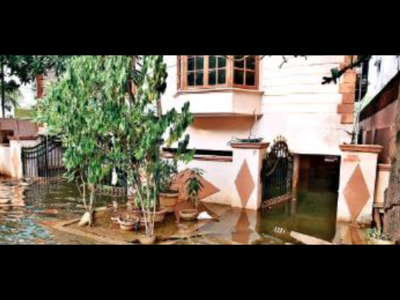The Hindu 22.11.2010
‘Pseudo bridges add to water-logging’
Smriti Kak Ramachandran
Pseudo bridges affect the river’s ability to meander
‘Bridges with longer spans, minimum construction on floodplains’
NEW DELHI: Encroachments on the floodplains in the form of constructions are the prime reason why floodwaters spread out into the city, but pseudo bridges built across the Yamuna riverbed too contribute to the phenomenon, say experts.
Barring the Old Yamuna Bridge, the rest of the bridges that have come up on the riverbed are pseudo ones, and have adversely impacted the flow of floodwaters. Experts point out that water-logging in the city occurs when floodwaters instead of being allowed to flow downstream or contained in water harvesting units are forced to stagnate.
“A bridge which is just part-bridge (just over the river’s channel) and primarily an embankment over a river is a pseudo bridge. Traditionally bridges have been built on piers and arches in such a manner that the floodwaters are not hampered and are allowed to flow downstream. This was also the reason why the narrowest stretch of a river was always preferred to build a bridge over a river as is the case with the British era Old Railway-cum-Road Bridge over river Yamuna in Delhi,” said Manoj Misra, convenor of NGO Yamuna Jiye Abhiyan.
The tendency to opt for pseudo bridges has affected the river’s ability to meander and prevent the floodwaters from spreading along the bank, he pointed out. “Ideally the floodwaters should be allowed to flow downstream, but in Delhi’s case, because of the rampant encroachment floodwaters begin to stagnate at a few places and since there is no space to spread out the column of water rose,” said Mr. Misra.
According to Mr. Misra, water storages are being created at places where floodwaters accumulate. “It is important to have storm-water drains to allow the water to flow downstream and also have channels for water storage along the drains so that the surplus water can be used in the lean months.”
“Hindrance that a cross embankment puts before a river in spate results in obstruction in the free flow of floodwaters down the gradient and excessive rise in groundwater levels. The cross embankment portion of the pseudo bridge causes the flood waters to stand and this is likely to be a reason for the flooding of basements in buildings in East Delhi,” Mr. Misra added.
IIT-Delhi Civil Engineering Head of Department Prof. A. K. Gosain said the administrators should consider “alternate options” to the pseudo bridges. “They should go for bridges with longer spans so that minimum construction occurs on the floodplains. These days many options are available, even if it means spending a little more.”
Prof. Gosain also cautioned against constructions on the floodplains. “This tendency to allow constructions on the floodplains has a serious repercussion. Over the years several constrictions including the Akshardham Temple and the Games Village have come up on the floodplains, but we must remember that in the end any river bed tampering comes at a cost.”


